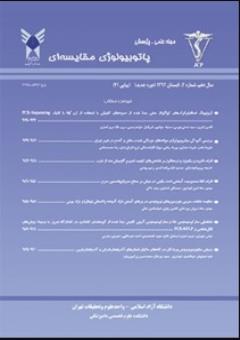نقش گیرندههای اورکسینی 1 و 2 در ناحیه آکومبنس بر پردازش حافظه اجتنابی غیرفعال در موشهای صحرایی
الموضوعات : پاتوبیولوژی مقایسه ای
لاله زکایی
1
,
اسماعیل اکبری
2
,
مرتضی زنده دل
3
![]() ,
وهاب باباپور
4
,
وهاب باباپور
4
1 - گروه علوم پایه، دانشکده دامپزشکی، واحد علوم و تحقیقات، دانشگاه آزاد اسلامی، تهران، ایران
2 - گروه فیزیولوژی و فارماکولوژی، دانشکده پزشکی دانشگاه علوم پزشکی مازندران
3 - گروه علوم پایه، دانشکده دامپزشکی، دانشگاه تهران، تهران، ایران
4 - دانشگاه تهران
الکلمات المفتاحية: گیرندههای اورکسینی, حافظه, ناحیه آکومبنس, موش صحرایی,
ملخص المقالة :
اورکسین نوروپپتیدی است که عمدتاً در نورون های داخل و اطراف هیپوتالاموس جانبی موضعی شده است و به دو گیرندهی اورکسینی نوع 1 و 2 متصل میگردد. حضور نورونهای اورکسینرژیک در ناحیه آکومبنس نیز به اثبات رسیده است. پژوهشهای پیشین نقش اورکسین در هسته رافه پشتی و هیپوکامپ را در فرآیندهای یادگیری و حافظه نشان دادهاند، اما تاکنون هیچ مطالعهای به اثرات اورکسین موجود در ناحیه آکومبنس بر حافظه اجتنابی نپرداخته است. در مطالعه حاضر، نقش گیرندههای اورکسینی 1 و 2 در ناحیه اکومبنس بر تثبیت و به خاطر آوری حافظه اجتنابی غیرفعال در موشهای صحرایی بررسی شد. به این منظور 24 موش صحرایی نژاد ویستار تهیه و 4 آزمایش در محیط شاتل باکس طراحی و اجرا شد. به گروههای آزمونی هر آزمایش پس از آموزش، به ترتیب محلول کنترل (DMSO)، آنتاگونیست گیرنده اورکسینی نوع 1 (SB334867-A) و آنتاگونیست گیرنده اورکسینی نوع 2 (TCS-OX2-29) از طریق کانول به ناحیه آکومبنس تزریق شد. نتایج نشان داد در مرحله تثبیت حافظه اجتنابی غیرفعال، تجویز SB334867-A مدت زمان ماندن در قسمت روشن و اولین زمان ورود به قسمت تاریک محفظه را به طور معناداری در مقایسه با گروه کنترل کاهش داد (05/0 p<)، در حالیکه تجویز TCS-OX2-29 اثر معناداری به دنبال نداشت (05/0 p>). در مرحله به خاطر آوری حافظه اجتنابی غیرفعال نیز تجویز مستقل SB334867-A و TCS-OX2-29 تغییر معناداری در مدت زمان ماندن در قسمت روشن و اولین زمان ورود به قسمت تاریک محفظه ایجاد نکرد (05/0 p>). با توجه به نتایج، احتمالاً حذف کارکردی گیرنده اورکسینی نوع 1 روند تثبیت حافظه اجتنابی غیر فعال را تحت تاثیر قرار می دهد و آن را مختل میکند.
1. Vorhees CV, Williams MT. Assessing spatial learning and memory in rodents. ILAR journal. 2014;55(2):310-332.
2. McDonald AJ. Functional neuroanatomy of the basolateral amygdala: Neurons, neurotransmitters, and circuits. InHandbook of behavioral neuroscience. Elsevier; 2020.
3. Jaeger LB, Farr SA, Banks WA, Morley JE. Effects of orexin-A on memory processing. Peptides. 2002;23(9):1683-8.
4. García-Brito S, Aldavert-Vera L, Huguet G, Álvarez A, Kádár E, Segura-Torres P. Increased training compensates for OX1R blockage-impairment of spatial memory and c-Fos expression in different cortical and subcortical areas. Behavioural Brain Research. 2018;353:21-31.
5. Farzinpour Z, Taslimi Z, Azizbeigi R, Karimi-Haghighi S, Haghparast A. Involvement of orexinergic receptors in the nucleus accumbens, in the effect of forced swim stress on the reinstatement of morphine seeking behaviors. Behavioural brain research. 2019;356:279-87.
6. Mannella F, Gurney K, Baldassarre G. The nucleus accumbens as a nexus between values and goals in goal-directed behavior: a review and a new hypothesis. Frontiers in behavioral neuroscience. 2013;7:135.
7. Alijanpour S, Tirgar F, Zarrindast M-R. Role of dorsal hippocampal orexin-1 receptors in memory restoration induced by morphine sensitization phenomenon. Neuroscience. 2016;312:215-26.
8. Akbari E, Motamedi F, Naghdi N, Noorbakhshnia M. The effect of antagonization of orexin 1 receptors in CA1 and dentate gyrus regions on memory processing in passive avoidance task. Behavioural brain research. 2008;187(1):172-7.
9. Han D, Han F, Shi Y, Zheng S, Wen L. Mechanisms of memory impairment induced by orexin-A via orexin 1 and orexin 2 receptors in post-traumatic stress disorder rats. Neuroscience. 2020;432:126-36.
10. Rahmani B, Ghashghayi E, Zendehdel M, Khodadadi M, Hamidi B. The crosstalk between brain mediators regulating food intake behavior in birds: a review. International Journal of Peptide Research and Therapeutics. 2021;27(4):2349-70.
11. Zhao X, xue Zhang R, Tang S, yan Ren Y, xia Yang W, min Liu X, et al. Orexin-A-
induced ERK1/2 activation reverses impaired spatial learning and memory in pentylenetetrazol-kindled rats via OX1R-mediated hippocampal neurogenesis. Peptides. 2014;54:140-7.
12. Telegdy G, Adamik A. The action of orexin A on passive avoidance learning. Involvement of transmitters. Regulatory peptides. 2002;104:105-10.
13. Walling SG, Nutt DJ, Lalies MD, Harley CW. Orexin-A infusion in the locus ceruleus triggers norepinephrine (NE) release and NE-induced long-term potentiation in the dentate gyrus. The Journal of neuroscience : the official journal of the Society for Neuroscience. 2004;24:7421-6.
14. Palotai M, Telegdy G, Ekwerike A, Jászberényi M. The action of orexin B on passive avoidance learning. Involvement of neurotransmitters. Behavioural brain research. 2014;272:1-7.
15. Paxinos G, Watson C. The rat brain in stereotaxic coordinates: hard cover edition. Elsevier; 2006.
16. Zokaei L, Akbari E, Babapour V, Zendehdel M. The Modulatory Role of Orexin 1 Receptor in nucleus accumbens (NAc) on spatial memory in rats. Archives of Razi Institute. 2022;21. http://doi.org/10.22092/ari.2022.360741.2599
17. Akbari E, Naghdi N, Motamedi F. The selective orexin 1 receptor antagonist SB-334867-A impairs acquisition and consolidation but not retrieval of spatial memory in Morris water maze. Peptides. 2007;28(3):650-6..
18. Khodabande F, Akbari E, Ardeshiri MR. The modulation of the spatial reference memory by the orexinergic system of the dorsal raphe nucleus. Life Sciences. 2021;265:118777.
19. Mavanji V, Butterick TA, Duffy CM, Nixon JP, Billington CJ, Kotz CM. Orexin/hypocretin treatment restores hippocampal-dependent memory in orexin-deficient mice. Neurobiology of learning and memory. 2017;146:21-30.
20. Yang L, Zou B, Xiong X, Pascual C, Xie J, Malik A, et al. Hypocretin/orexin neurons contribute to hippocampus-dependent social memory and synaptic plasticity in mice. Journal of Neuroscience. 2013;33(12):5275-84.
21. Selbach O, Bohla C, Barbara A, Doreulee N, Eriksson K, Sergeeva O, et al. Orexins/hypocretins control bistability of hippocampal long‐term synaptic plasticity through co‐activation of multiple kinases. Acta physiologica. 2010;198(3):277-85.


